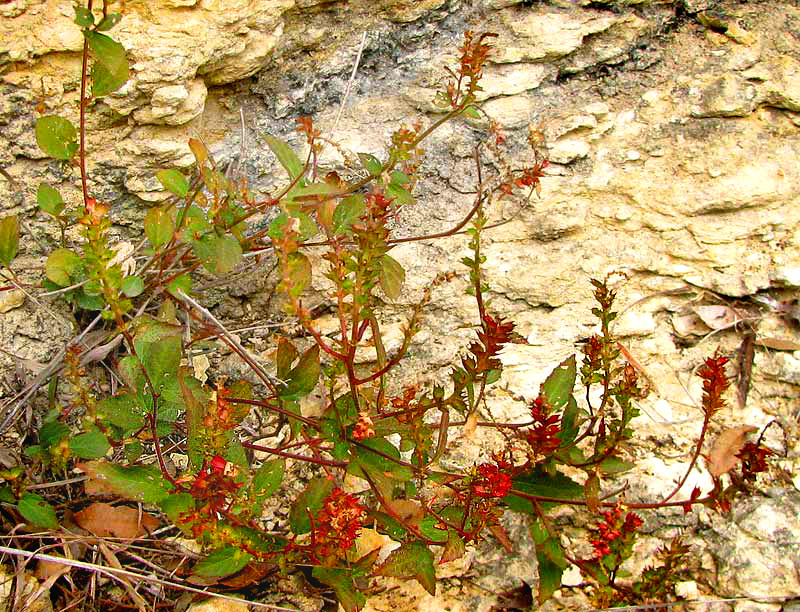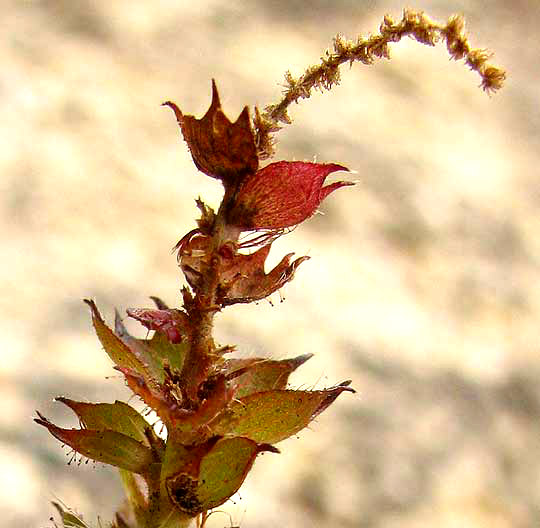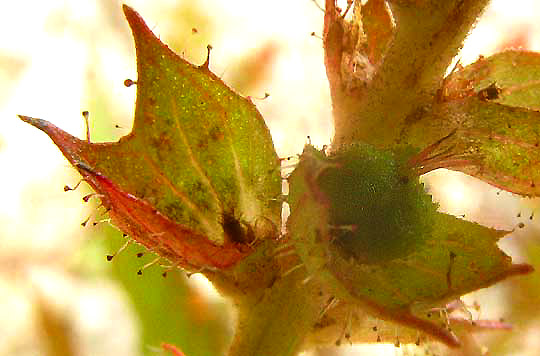Excerpts from Jim Conrad's
Naturalist Newsletter

from the December 8, 2013 Newsletter issued from the Frio Canyon Nature Education Center in the valley of the Dry Frio River in northern Uvalde County, southwestern Texas, on the southern border of the Edwards Plateau; elevation ~1750m (~5750 ft); N29.62°, W99.86°; USA
SHRUBBY COPPERLEAF
Along a rocky arroyo -- an arroyo being a usually dry stream in arid country -- where water had scoured out a niche below an overhanging limestone ledge, a much-branched, knee-high bush leaned toward the light, its leaves turned reddish or coppery by recent freezes, as shown above. You can see that this plant's branches are tipped with flower clusters. A close-up of a cluster appears below:

This inflorescence is past its flowering time. The slender, brownish upper part of the spike bears remains of male flowers. Each leafy item below the male section is a bract, or modified leaf, subtending a female flower. A peep into some bracts appears below:

In that picture, the bract at the lower, right folds around a green, three-lobed, more or less oval fruit topped with three deeply forked styles. We've seen unisexual flowers and this kind of fruit so frequently that already we know the plant is a member of the big Euphorbia or Poinsettia Family, the Euphorbiaceae. Within that family, a big genus noted for subtending its female flowers and fruits with deeply toothed, leafy bracts just like these is the genus Acalypha. Species in Acalypha often are known as copperleafs. In October we looked at the Round Copperleaf, Acalypha monostachya. You might enjoy comparing our present plant's features with those of the Round Copperleaf at http://www.backyardnature.net/n/h/acalypha.htm.
Our current, beneath-the-ledge copperleaf often is called the Shrubby Copperleaf. It's ACALYPHA PHLEOIDES, mainly a species of Mexico and Guatemala, but in the north it extends into the US in central and western Texas, and southern New Mexico and Arizona.
In the last picture a striking feature is that the bracts bear large stalked glands. Most similar pictures on the Internet show bracts with few or no such glands, so maybe our plant is unusual for that. However, the species is noted for being very variable. In fact, for many years our plants were regarded as "Lindheimer's Copperleafs," Acalypha lindheimeri, but the expert preparing the Acalypha section to be published in the Flora of North America considers "Lindheimer's Copperleafs" to be mere variations of Mexico's Shrubby Copperleafs.
In Mexico teas made of the Shrubby Copperleaf's aboveground parts traditionally have been used for a variety of gastrointestinal disorders. Research done in Mexico finds that the plant contains thymol, camphor and gamma-terpinene, which do indeed function as antispasmodic agents -- which means that they suppress muscle spasms.
Entry from field notes dated August 31, 2023, taken in Los Mármoles National Park in the Eastern Sierra Madre mountains, Hidalgo state, MÉXICO, along steeply climbing road heading eastward out of town of Trancas {on maps designated "Morelos (Trancas)"} toward Nicolás Flores; juniper/pine forest on limestone bedrock; elevation ~2,200m (~7,200ft); (~N20.801°, ~W99.254°)
SHRUBBY COPPERLEAF IN CENTRAL MEXICO
The Flora of North America" says of Shrubby Copperleaf, Acalypha phleoides, that "Although plants from Texas generally can be distinguished from plants from central Mexico southward, plants from intervening regions in the United States and Mexico include a full range of intermediates." This species is variable, its various forms south of Texas are not well documented, and I'm only hoping the pictures appearing below show how the plant looks here, and not a different species I don't know about.


The above shows a plant growing on a very rocky, steep and nearly always shaded and frequently cow-grazed slope. The plant bears spikes of strictly male flowers on peduncles about 3.5 long. The close-up at the right shows male flowers consisting of four sepals, no petals, and what appears to be 4 stamens.

Above, spikes of female flowers on a separate plant are shown. Four plants within a small area bore only male flowers, and only this plant produced female flowers. Unlike our Texas plant, here all flowering spikes on the various plants bore only male or female flowers. Here's a close-up of some female flowers:

The slender, white or pinkish threadlike items are style branches. Usually two styles arise atop each ovary, which is subtended and largely hidden within a green, deeply lobed bract. Note that most bracts produce only two or three lobes, and they're sharply pointed. A striking difference between these bracts and those on our Texas plant is that here no stalked glands are visible, while on the Texas plant they were large and conspicuous.
The Flora of North America describes the lower surfaces of this species' female flowers' bracts as sparsely hairy and with stalked, or stipitate, glands. However, the Flora fanerogámica del Valle de México, providing the most complete description of this species in upland Mexico I can find, represents this species in Mexico's high-altitude central valley as provided with minute, sessile glands and only sometimes with stalked glands -- "... provistas de glándulas sésiles, diminutas y en ocasiones de glándulas pediceladas."
The Flora fanerogámica del Valle de México also notes that two varieties of our species have been recognized, but that the features distinguishing the varieties are inconsistent.
Here I think we're seeing evolution in process, and classical taxonomy hasn't caught up with Nature's rambunctious experimentation.